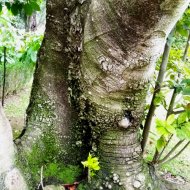Care of the plant Ocotea foetens or Stinkwood |
|
The genus Ocotea, family Lauraceae, includes more than 200 species of trees and shrubs native to South America, Macaronesia and Africa. Some species are: Ocotea foetens, Ocotea acutifolia, Ocotea venenosa, Ocotea quixos, Ocotea floribunda, Ocotea mascarena, Ocotea leucoxylon. Common name: Stinkwood. Sinónimo científico: Laurus foetens. Ocotea foetens is an evergreen tree with a dense crown and branches from the base that reaches 30 meters (98.42 feet) in height. The bright green, lanceolate leaves measure up to 12 cm (4.72") in length. The small flowers produce a perfume similar to that of the European Linden. It blooms in spring and summer. Fresh wood produces a bad smell. Stinkwood is used as an isolated specimen and in parks and public gardens. They are ideal for humid coastal gardens in frost-free climates. Ocotea foetens prefers semi-shade exposure avoiding direct sunlight in the central hours of the day, especially in Mediterranean climates. It is important that the environmental humidity is high. It does not resist frost. Stinkwood grows well in deep soils that contain abundant organic matter. Water frequently so that the substrate never dries out completely. It does not resist drought. Fertilize with compost or manure in autumn. Stinkwood tolerates light pruning after flowering to maintain a compact appearance. This plant does not usually present serious problems with pests and diseases. Ocotea foetens is propagated by cuttings taken from the suckers it produces at the base. |
Images of the plant Ocotea foetens or Stinkwood |
Find plants
Ocotea foetens or Stinkwood | Care and Growing
© 2025 FavThemes


